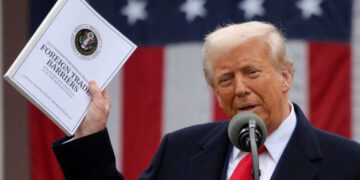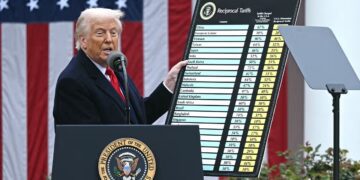By John F. Di Leo -
As business publications look back on the first half of the Trump administration – in particular, on the trade war that ratcheted up in 2018 – they are bound to conflate politically-motivated changes with non-political ones. This may be partially unavoidable; there is after all a political aspect to everything, and with tariffs on top of everyone’s mind for a full year, such things certainly do play a part.
But it’s going too far – much too far – to assume that such changes are completely, or even primarily, caused by shifts in public policy. Often, business world changes are overdue, and political shifts may just give rhetorical cover for a decision that’s been postponed too long already.
As just one example, the January 24 edition of the Economist led with a feature with the gripping title, “The Steam has Gone Out of Globalization,” which includes the perfunctory message that “Mr. Trump’s trade war” is a part of the cause, while otherwise acknowledging the truth that this change has been ongoing for at least a decade.
The Economist calls it a switch “from globalization to slowbalisation” – not an end to international trade, but a new sluggishness, not necessarily because of recessions or tariff cost increases, but for a better reason: because sometimes going global just isn’t a good idea… period.
With so many business consultants and publications having made their mark – and their fortune – by preaching a gospel of “Low Cost Country sourcing,” the recognition that LCC efforts should really never have been the be-all and end-all of business planning is practically viewed as heresy. So, as the opinion leaders backtrack, they will say that the transportation savings have already been maximized, that the world is moving from a products economy to a service economy, that public opinion is shifting, and so forth.
But if honesty is desired at all – as it should be – we should admit the truth: that, just as the vendor across the street might not be the perfect vendor for you, the vendor across the ocean might not be the perfect vendor for you, either!
In selling the outsourcing gospel for so many years, consultants and thought leaders (what a term, huh?) would remind people of the obvious benefits – 3rd world salaries are so much lower, the third world has newer manufacturing machinery; you can move materials by ocean container so cheaply; 3rd world environmental and employer regulations are so much less burdensome; and did we mention that 3rd world salaries are so much lower?
Such a message is irresistible to a business world traded on the stock market, able to cause an uptick in stock price (and massive paper earnings increases for the stockholders) at the slightest mention that some great cost savings has been achieved.
But what the gurus of globalization never mentioned is the other reality of international commerce: The need for a business to master the laws of not one but multiple countries, the need for flying engineers and managers back and forth across the ocean all the time to design and manage these remote vendors or remote owned-plants (and joint ventures with the host government, as in the China model), and the incredibly slow supply chain when things go wrong.
Let’s focus on this last point for a moment. When things go right, you can plan for it. If I know I will need something in the American Midwest on February 1, I can have it shipped in late January from anywhere in the continental USA… or I can have it shipped from anywhere in Europe two or three weeks earlier than that… or I can have it shipped from anywhere in east Asia by late December, or I can even have it shipped from India, halfway around the world, by the beginning of December. Allow enough time, and all will be well.
But what happens when things go wrong? If you sell out sooner than expected and you need more shipped quickly, what does that six-or-eight week lead time do to you? Or if an order arrives and fails the quality tests, and needs to be improved, reprocessed, or replaced? Now you’re spending ten times as much on airfreight instead of seafreight, and all those wonderful savings from the low labor costs of the 3rd world have been for naught.
The simple truth is, while there is great benefit to sourcing many things from abroad, there are also great benefits to sourcing other things close to home. If a Chicago manufacturer needs a rush replacement order of parts by the weekend, the cheap truck rate from Milwaukee or Indianapolis may well make up for the cheaper piece-price savings of the Chinese factory.
For years, we were told that “Just in Time” (JIT) planning was the gold standard in manufacturing, but as carrier and port strikes, engineering and quality challenges, and even bad weather can cause long delays on the international supply chain, we have seen that, too often, JIT (Just In Time) really means JTL (Just Too Late).
We should give some credit to the Trump administration on two areas on which politicians usually remained silent, but his administration has kept on their radar screen and in their rhetoric:
- First, the loss of intellectual property by sourcing abroad. While there will always be the risk that competitors will reverse-engineer an invention, most foreign countries in that space not only don’t have our respect for trademark, copyright and patent, their governments outright bless the undermining of foreign IP rights. It’s bad enough when you hire a foreign factory to make your purse, and a cheap copycat across the street from your vendor starts making shoddy copies with your label on it… but it’s even worse when the very foreign factory you hired uses your dies, your materials, your plans to not only make the quantity for which you contracted them, but then also makes more themselves for their own distribution, in contradiction to your contract. It happens all the time… and such countries sometimes even reward their factories for doing it (such governments are inclined to side with their own companies, not with the poor foreign mark who got taken).
- And second, all these years of mass outsourcing has caused a complete loss of whole industries here, not only in the finished products, but in the raw materials and intermediate components that make them up. When we make a car or refrigerator here, for example, it includes parts from all over the world. We would assume that other countries would be the same, but too many (especially in the third world) are not. The finished product made in China is much less likely to include foreign parts than our finished product is. The Chinese product may indeed be almost all-Chinese. Not that there’s anything wrong with that, exactly, on an individual basis, but it does lend credence to the position that we aren’t on an even playing field. We have lost so many foundries, injection molding shops, toolmakers and other intermediate industries, we desperately need to gain them back, in order to gain back our finished product manufacturing as well.
For these reasons, along with many others, the US Trade Representative is making small but important changes to both our free trade agreements and our other global trade negotiations – making enforcement of IP protections mandatory, for example, and demanding greater percentages of domestic component content in finished products, “or it’s no deal.”
There are ways, for example, to make a product in the USA entirely from imported materials (if you do it right, with enough local labor and profit), and still qualify that finished product for NAFTA benefits. That wasn’t the intent of the original deal, but that’s how it turned out. This kind of shortcoming in both NAFTA and our other trade agreements has played a role in causing the loss of those raw and intermediate manufacturing industries… and it could be easily fixed by simply setting reasonable minimum domestic percentage requirements in our free trade agreements (FTAs).
What we see on the horizon, in this ongoing change in the supply chain away from total globalization, is therefore not a lack of business activity, as some of the globalist-advocates fear, but rather, a rush of business activity in a different direction, one that they just aren’t used to tracking.
Hopefully, instead of an American manufacturer buying so many of his motors, castings, bases and paints from across the Pacific, he’ll buy more from vendors in his own state. These purchases won’t show up on the import stats, but the purchases occur nonetheless. And the more local purchases there are of these domestic materials, the more their prices will drop, as American vendors are no longer the second-choice source for their parts (just for when there’s a disruption from the foreign vendor), but finally become the first choice source again.
We shouldn’t fool ourselves into thinking we can, or even should, ever regain all the business we have lost to foreign shores. For some products and parts, it will always make sense to buy them from foreign low cost countries… products on which intellectual property rights, speedy shipment, and quality levels aren’t such a big deal. But for others – where IP, speed, and quality are critical – it never did make sense to outsource them, and it was practically malpractice to do so in the first place.
We are already seeing a new wave of domestic manufacturing arise here in the United States, as steel mills and machine shops reopen that had long been closed, as new enterprises arise (with the newest machinery and methods), showing that it’s now the 3rd world competitors that are obsolete. It will take time, but recent federal tax and regulatory changes, combined with this new effort in international trade policy, are helping to usher along this move in the right direction.
Businesses are warned that such changes don’t come freely; just as there was a host of things to do when they moved so much of their sourcing abroad 20 years ago, they’ll have to go through all those same steps today as they right-size their supply chain mix, perhaps even more so:
Every time you re-source a product, even in bringing it back home to a local vendor, there’s Country of Origin marking to change on your product and packaging, UL and NSF approval to reapply for, export controls to review, Free Trade Agreement qualifications to reassess.
The ‘move teams’ managing such sourcing changes will rightly have their hands as full, moving in this direction, as they did when they originally moved in the other direction.
The United States of America have long needed a manufacturing renaissance, and we’re not alone. We’re not the only ones to have succumbed to China’s magnetic draw over the years. Canada, Mexico, Britain and Europe have all lost too much of their domestic manufacturing over the years too, and their burdensome regulatory states will make it even more difficult for them to win it back than it has been for us.
Change is always a challenge, but when that change is for the better, it’s well worth the effort. The current change (“from globalization to slowbalization” is catchy enough, so we’ll take it) may be mischaracterized a bit, but as long as it represents the resuscitation of American manufacturing, especially of those raw materials and intermediate products we so desperately need as a foundation for full employment and economic prosperity, there’s no excuse for complaining about it.
Nothing is easy, nothing is automatic. But the long-term trend is finally a good one. Instead of “importing everything,” as so many gurus advised for so long, now we’re finally getting back to the more reasonable advice of “import the stuff that makes sense to import, and buy domestically what it makes sense to buy domestically.”
That’s really how it should have been all along, isn’t it?
Copyright 2019 John F. Di Leo
John F. Di Leo is a Chicagoland-based actor, writer, Customs broker and trade compliance trainer and consultant with DTTS Trade Compliance Seminars. His columns are regularly found here at Illinois Review.
Don’t miss an article! Since this site is shadowbanned by some in social media, feel free to use the link in the margin to sign up for Illinois Review’s free email notifications when new content is published!







